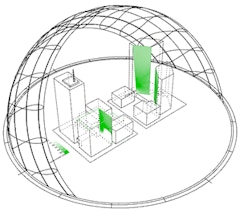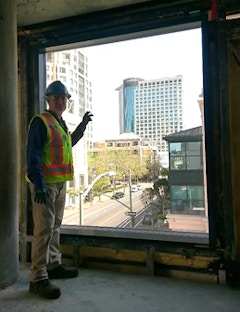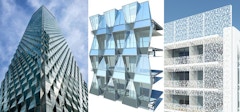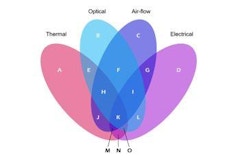
145 results
-
 Kinetic or responsive facades have been developed to improve buildings' daylighting conditions while mitigating energy consumption. Still, these…
Kinetic or responsive facades have been developed to improve buildings' daylighting conditions while mitigating energy consumption. Still, these… -
Generative Design Tool
- Paper by Amir Hosseinzadeh Zarrabi · Mona Azarbayjani · Maryam Tavakoli
The piezoelectric facade as a self-sustained technology can generate a considerable amount of energy by converting swaying motions (actuated by the
-

End-of-Life Challenges in Facade Design
- Paper by Rebecca Hartwell · Mauro Overend
In recent decades, there has been increased attention to reduce the operational energy performance of buildings. Stringent legislation on building
-

Climate-Oriented Prefabricated Building Envelopes
- Paper by Sridharan Gandhi · Andrew Tsay Jacobs, AIA, EIT, LEED AP BD+C · Karen Kensek, Assoc. AIA, LEED AP BD+C
Facades developed in response to climactic factors increase performance and human comfort while reducing energy loads. A single building envelope
-

Performance-based Facade Framework
- Paper by Mahsa Minaei · Ajla Aksamija
Buildings have a considerable impact on the environment, and it is crucial to consider environmental and energy performance in building design.
-

Fire Safety and Code Challenges for Mass Timber in Curtain Wall Systems
- Paper by David Barber · John Neary · Mic Patterson PhD LEED AP+
With the desire for more sustainable construction and reduced embodied energy, mass timber is being explored for building structures. For medium and
-

Green Façade/Roofs Design Tool
- Paper by Abolfazl Ganji Kheybari · Morteza Kasravi
Climate change and related thermal issues, draw attention to the impact of green facades and roofs on energy savings and thermal comfort. Besides, by
-

Environmental Facade Perspective
- Paper by Patricia Shaw, M Arch., MSc Facade Engineering
Designing a sustainable rainscreen wall assembly has become an essential part of most new construction projects. Industry principles and energy codes
-

Architectural Shape Optimization
- Paper by Patricia Edith Camporeale, PhD
This paper explores the architectural shape optimization of typical housing typologies: slab and high-rise residential buildings to reduce primary
-
Integrated Building Control System
- Paper by Jae Yong Suk, Ph.D. · Keith Graeber, PE · Andrew Harper, PE · Michael Siminovitch, Ph.D.
Integrated management of commercial lighting, heating, ventilation and air conditioning systems is considered as one of the most promising building
-
Evaluating The Environmental Performance Of Stick Curtain Wall Systems
- Paper by Dima Othman · Daniel Arztmann
The construction industry is one of the greatest sources of pollution, where 39% of global energy-related carbon emissions are attributed to
-

Two Sides to Sustainability & High-performance
- Paper by Brian Fraumeni · Julia Ragragio Ruiz, LEED AP BD+C · Adam Moqrane
High performance can be defined as “a building that integrates and optimizes all major high-performance building attributes, including energy
-

Terra Cotta Skins
- Paper by Laura B. Garofalo
This paper will address the potential of ornamental architectural terracotta surfaces to mitigate the effects of climate fluctuations that will
-

Sustainable Silicone
- Paper by Jon Kimberlain · Adrienne Bowman-Grittini · Stanley Yee
Silicone materials have a long history in high performance building projects. Known for durability, they can reduce a building’s carbon footprint by
-

Designing with Photovoltaics
- Paper by Wayne Walker · Julia Ragragio Ruiz, LEED AP BD+C · Sam Crawford
Photovoltaics (PV) have been utilized in buildings for decades, especially in Europe where legislative support has largely driven the market. With
-
Exo-Skins
- Paper by Nick Braaksma · Malini Srivastava, AIA · Chad Ulven
Cost-effective, sustainable, self-actuating, thermally-responsive, bio-composite exo-skins that act like shields or cloaks for existing buildings
-

Put Your Sweater On!
- Paper by Eric Haas, AIA, LEED AP BD+C, Adjunct Associate Professor
During the particularly cold first months of 1977 President Jimmy Carter, in what some call “The Sweater Speech,” famously noted how much energy… -

Infinite Panel System
- Paper by Mike Ryan · Brian Stern · Michael Adams
Today, building facades are expected to do much more than merely provide shelter, which is driving the need for higher performing envelope solutions.
-

Geometric Patterns as Architectural Forms
- Paper by Joshua Schultz, PhD, PE, LEED AP · Neil Katz, AIA
Facade design is a key component of architectural expression, and increasingly a key design consideration due to growing importance of factors like:
-

Innovative Façades for a Sustainable Architecture
- Paper by Lucio Blandini
Facades play a relevant role in the search for a more sustainable approach to modern architecture. The amount of embodied and operational energy can

